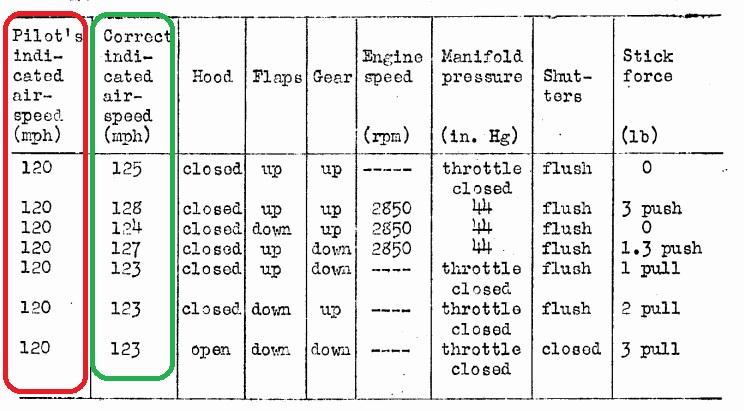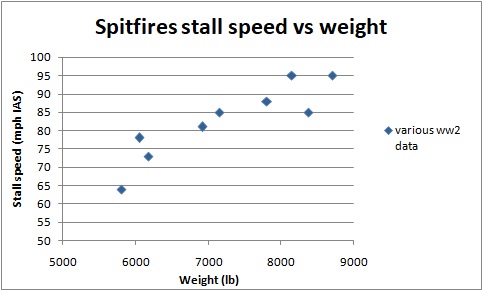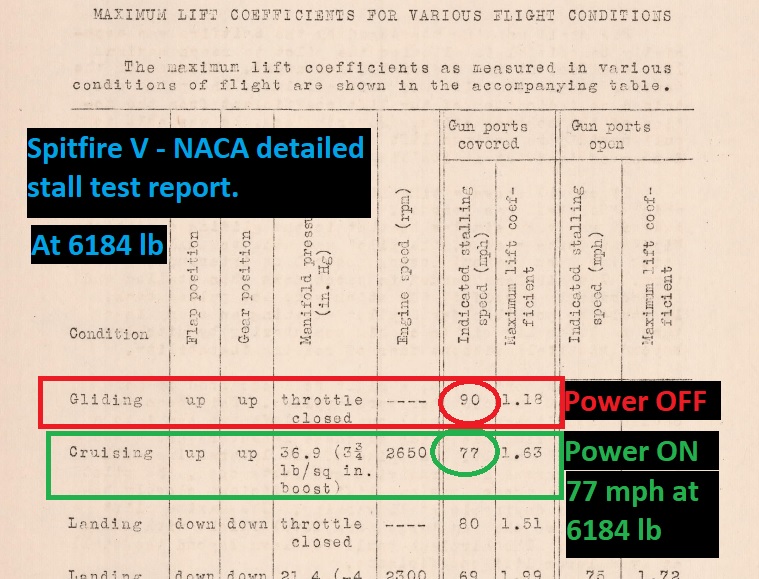Finn wrote:
Not trust the POH? are you freaking kidding? Pilots bet their lives on the POH. If the POH is incorrect it's usually corrected in pen by the pilot who is given the correct number.
You trust the POH about boost- even tho' boost is infinitely variable in a real spit, and there is no logical reason why a spit 9 should use 12 lbs of boost for an hour, but the XIV can only use 9lbs. Some numbers in a POH are suggestions, some are facts that pilots have to live with.
Stall speed has to be right- within very small limits in the POH. Period.
Your stall numbers for the SPIT 9 are correct...but they apply to the CLIPPED WING Spits only... as is written in the part under the chart that you DON'T show here... Spits with regular wings will stall between 6 mph or 3 kts slower. so the MPH figure for a normal spit would be about 84mph. or 75kts. Further, the stall speed is in IAS. it doesn't change with altitude although the true airspeed does.
<S> sir!
No, I'm not kidding. I've read over 50 POH's, compared them to ww2 trial data, NACA data, calculating the theoretical stall speeds etc while trying to wrap my head around the stall speed for each of the 100 fighters I've remodeled. The POH is not always correct, and in many cases I would say it is correct and not correct at the same time. This for several reasons.
For one the pitot tube might not always give exact measurments for the cockpit's speed gauge. For some ww2 trials there are tables provided to convert the IAS shown on the cockpit speed gauge to the real IAS speed accounting for pitot tube error. The gauge IAS speed shown for the pilot is often slightly lower than the real IAS. The F6F Hellcat is the prime example where Grumman engineers could not understand why the F4U, using the same engine, was so much faster according to the speed gauges, until Vaught borrowed Grumman a F4U to run tests with against the F6F. In these tests it was found that the F6F and F4U had near identical top speeds, flying side by side, and the supposed inferior speed of the F6F was only a misconception owed to turbulent airflow around the pitot tube making the speed gauge of the Hellcat showing a notably lower IAS speed than the actual real IAS speed. Errors like this also affect the stall speed measured in ww2 trials, and it's smarter to write down the speed shown on the cockpit gauge for the POH, than the mathematically correct stall speed. This since the pilot has to rely on the gauge. For building flightmodels however one wants the mathematically correct stall speed since we don't have these pitot tube errors in the sim.
You are correct the Spit XIe numbers are for clipped wings, I had to respond in a hurry so forgot to account for this. As you state the stall speed is then around 84-87 mph (3-6 mph reduction) at 7150 lb. I'll go with a 5 mph reduction for non-clipped wings so this gives 85 mph stall speed at 7150 lb. The Spit XIV POH states a stall speed of 85 mph... at 8375 lb. So assuming the POH can never be wrong... a weight difference of 1225 lb makes none or only a single mph difference? It goes against all known physics though. The Spit IX manual also states a stall speed of 95 mph ( 100 mph for clipped wing) at 8700 lb. Calculating by interpolation this results in a stall speed of 93 mph at 8375 mph for the Spitfire IX's POH if using normal full span wings. The Spitfire XIV's POH still states 85 mph at the same weight. So how do we move on with this if we assume the POH can not be incorrect? Also the 85 mph at 7150 lb in the Spitfire IX POH is for an "aircraft without rear-view fuselage". A spit with rear-view fuselage stalls at 5-17 mph higher stalls speeds. Using these numbers a Spitfire IX would then stall at 106 mph at 8375 lb, which is even further from the 85 mph of the Spit XIV at this weight. Since I'm not 100% sure about the "rear-view fuselage" issue, or why it would increase the stall speed by so much, which seems very strange, let's just stick with 93 mph for the Spit XI at 8375 lb vs the 85 mph of the Spit XIV at this weight. We can also look at other trials. This one for example shows a stall speed of 95 mph at 8145 lb, which should result in around 97 mph at 8375 lb.
http://www.spitfireperformance.com/Spit ... ndling.pdfSo at 8375 lb we now have the Spitfire's stall speed stated as 93 mph and 85 mph from two different POH's, and 97 mph from a ww2 trial. Looking at even more trials we'd get even more different numbers for the stall speed for the same airplane. The chaos has just started! I'm willing to commit blashpemy and say that one or both of the POH's might actually be incorrect.
What makes it unwise to compare the POH stall speed to the stall speeds from my tests though, is that the stall speed in the POH is made from real life pilot tests, while mine are made on auto-pilot with the HUD telling me the exact milisecond where the G's go from 1.0 to 0.9 G's. This would be impossible to measure in a real life test. And it would be near impossible to keep the airplane flying perfectly right at 1.0 G's to start with. In a perfect stall test I get the power ON stall speed of the Spitfire XIV to 89 mph at 75% fuel. If turning off the sound for the stall buzzer though (in real life ww2 planes didn't have a stall buzzer), and flying manually trying to feel the stall, I would have estimated it that the Spit XIV starts to fall out the sky at 79-84 mph, since this is where I can actually notice the nose and wings starting to drop. This is 5-10 mph below the mathematically correct stall speed I get from a perfect auto-pilot test, and can explain why a ww2 stall test shows lower numbers than the stall number I've presented in the vehicle info. This can also explain why the stall speed varies between different ww2 tests for the same plane, since it's up to the test pilot to define the exact milisecond where he estimates the plane is stalling, and near stall the airspeed is decreasing rapidly so every split of a second extra will result in a lower estimated stall speed. In real life there are also small differences in quality between the planes.
What I can say is that the best way I've found is to collect all stall data I can find for a flightmodel, try to make sense of it since all tests will often show a different number, then compare it to the stall speed I get from using my method of calculating it. For the P-39 Airacobra there is very detailed calculated/tested NACA stall data available. The method I use for mathematically estimating the stall speed of a flightmodel matches perfectly to the NACA data for the P-39, and has also given correct results vs other NACA tests and relative stall numbers when comparing different fighters. I have retested the Spitfires and compared them to all the other fighters, setting the weight to match a wingloading of 30.0 for all airplanes so that I can measure their relative stall speed, looking at the max AoA, airfoil and wing thickness ratio etc. Looking at these tests I believe the Spitfire's stall speed is where it should be compared to all the other flightmodels I've remodeled. Lowering it by several mph would not make sense relative to the other fighters as the Spitfire's stall speed at 30.0 wingloading would then be lower than what planes with thicker wings and a higher max AoA have at the same wingloading.
Here is an example from a very thurough NACA report on the Spitfire V that shows the difference in the IAS that the pilot sees on his gauge (which would be used for stall speeds in the POH), and the correct IAS, which is what we use in the game (No pitot errors in Warbirds).

When modeling the Spitfires I found many different stall speeds for the various variants. Not always clear if power ON or OFF. Some of those were:
64 mph - 5804 lb
78 mph - 6050 lb
73 mph - 6172 lb
81 mph - 6917 lb
85 mph - 7150 lb
88 mph - 7800 lb
95 mph - 8700 lb
85 mph - 8375 lb
95 mph - 8145 lb
Plotted in a graph we get quite an arbitrary picture

I now however remember how I finally determined the stall speed (liftco) for the Spitfire series. It was by doing my own estimations, and comparing these to the very detailed NACA test of the Spitfire V. This test is as thorough as it gets, and stated a stall speed of 77 mph power ON at 6184 lb. If you take a Spitfire Vb and use 45% fuel (6184 lb), you can go autopilot, turn off the engine, and see that the very moment where the G's meter in the HUD goes from 1.0 to 0.9 G's, is exactly at 77 mph for the Spitfire series, as per the NACA tests. (In Warbirds the stall speed doesn't vary with engine ON/OFF, so we're using power ON as a basis for all flightmodels). The whole Spitfire series uses the liftco setting that was used to match the NACA test and as such the Spitfires in Warbirds should be quite on par with their real life stall speeds. This liftco setting results in an 89 mph stall speed at 8288 lb, which is the weight of the Spitfire XIV at 75% fuel.
You can find this NACA test at:
https://ntrs.nasa.gov/archive/nasa/casi ... 092581.pdf
Cheers!

/Robert